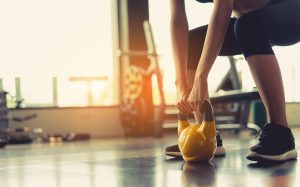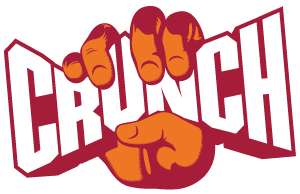
Training your lower body to be strong, functional and toned needs variability of training utilising a mix of compound leg exercises, leg toning exercises and the best kettlebell leg workout you’re not doing. The best part? This routine could be your new workout at home as all of these leg exercises can be done at home with kettlebells.
Progressive overload has gotten a lot of popularity by fitness gurus in recent years but one thing that is often overlooked is that we can also progress the stimulus by deviating the centre of mass of an exercise and the required stability demand of the weight being used, which is where kettlebells come in.
In this blog, we’ll cover what we think are the best exercises as well as how to set up and execute these movements properly to ensure you get the most out of them.
Kettlebell leg exercises for the hamstrings
B Stance Romanian Deadlift (RDL)
The b-stance RDL is a great deadlift variation to help improve your hinge pattern, due to the staggered stance nature of the movement will allow you to focus a little more load into one leg whilst challenging the internal rotation of your hips which is going to give you a lot of bang for your buck with this exercise.
Set Up:
- Start by standing with your feet close together.
- Hold the kettlebell with both hands at your waist level.
- Pivot on the heel of one of your feet rotating your toes clockwise to 90 degrees, then pivot on your toes rotating your heel 90 degrees anti-clockwise. You should have one foot a few inches behind the other leg with most of your weight distributed on the front foot.
- Now hold the weight on the opposite side of the stance leg (the leg that’s forward).
Execution:
- Soften your knees and begin to hinge at the hips, focusing on pushing your hips back as you lower the kettlebell towards the ground keeping it close to the thigh, as a given rule aim for about mid shin for range of motion.
- Pause when you reach this range, then you’re going to reverse the movement driving your hips forward using your glutes and returning back to a standing position.
Top tip: Perform this exercise in front of a wall and try to tap the rear wall with glutes as you hinge back ensuring both sides tap the wall evenly.
Single Leg Deadlift / One-Legged Deadlift
This advanced deadlift variation is going to challenge your trunk stability focusing on improving your anti-rotational strength, loading your hamstrings and glutes and improving overall strength, stability and mobility all in one.
But ensure you’ve mastered the B Stance Romanian Deadlift and feel strong and stable enough to give this variation a try.
How to perform a kettlebell one-legged deadlift:
Set Up:
- Start by standing straight ensuring a stacked ribcage and pelvis holding a kettlebell in one hand.
- Lift the foot on the same side (ipsilateral) as the kettlebell off the ground.
Execution:
- If your mobility allows keep a straight leg on the stance leg, if not slightly soften the knee and start to hinge at the hips, lower your torso until it’s parallel to the ground whilst pushing the opposing leg back to 90 degrees in an almost kickback like fashion maintaining a neutral spine. Aiming for the kettlebell to be in line with your stance legs shoelaces and hitting a depth of about mid shin as a reference point.
- Return to the upright position by lowering the leg back down whilst standing upright and driving your hips forward using your glutes and hamstrings.
Top Tip: If you struggle with stability performing this movement use a dowel rod or a wall to aid in balance initially to get used to the movement pattern.
Stiff Leg Kettlebell Deadlift
Want to improve your hamstring mobility and strength then look no further, this stiff leg deadlift variation is going to lengthen your hamstrings and give you a world of benefits.
How to do a stiff leg kettlebell deadlift:
Set Up:
- Start by starting with your feet hip-width apart holding a kettlebell with two hands in front of you.
- Keep your legs straight or a very slight bend at the knees.
Execution:
- Hinge at your hips, keeping your legs as straight as you can, a good cue I like to use is pushing your hips back whilst keeping your glutes as high as you can maintaining a flat back.
- Aim to hit a 90-degree angle with your torso parallel to the floor and you should feel a stretch in your hamstrings, then use them to pull your body back up to your starting position.
Top tip: Exhale at the top of the movement and inhale through your nose as you descend to improve trunk stability and bracing.
Kettlebell leg exercises for the quadriceps and glutes
Goblet Squats
If there’s one exercise to get extremely good at, it’s the goblet squat. Using a kettlebell and anterior load (holding the weight in front of you) is going to be a great variation for almost every person and you’ll reap the benefits of improving mobility, strength whilst pushing your centre of mass back with the counterbalanced weight.
How to achieve a kettlebell goblet squat:
Set Up:
- Start by holding the kettlebell upside down and grabbing the horns at chest level.
- Stand with your feet shoulder-width apart and make sure your ribcage and pelvis are stacked.
Execution:
- Start by breaking at the hips then lower your body in a squat bending at the knee and sitting back.
- Keep your chest up and back straight throughout the movement trying to keep an upright torso, you can use the kettlebell to counterbalance your weight as you lower yourself down aiming to get your hips below a parallel angle of your knees.
- Once you’ve hit depth, pause for a second and then drive through your heels to return to your standing position.
Top Tip: Maintain whole foot pressure throughout and a common mistake is to squeeze your glutes at the top of this movement, your glutes are most active in the bottom position not the top, this is where the least tension is put across the glutes and can irritate your lower back.
Sumo Squats
A popular variation to train your lower body and for good reason, the slightly wider stance squat variation is going to target your adductor muscles which sit on the inside upper thigh (groin area) and are important muscles to help improve mobility at the hips and improving strength and stability for running, walking, jumping and everything that involves your gait.
How to do a kettlebell sumo squat:
Set Up:
- Start by standing with your feet an inch or two wider than shoulder-width apart, toes slightly externally rotated (pointed out).
- Hold a kettlebell with two hands, letting it hang in front of you.
Execution:
- Break at the hips and bend at your knees lowering your body into a squat position, keeping your ribcage and pelvis stacked and lowering the kettlebell down towards the floor, stop a few inches from the floor keeping your chest and torso upright and kettlebell stopping a couple of inches from the floor. Push through your heels and return to your starting position then repeat for desired reps.
Top Tip: Focus on squeezing your inner thighs together and driving your hips into the kettlebell at the top
Kettlebell Step Up
Want to improve your lower body strength, tone your glutes and build a booty you can’t wait to show off? This exercise comes with heaps of benefits improving your hip stability by strengthening the function of your glutes and is a staple for most lower body training programmes if you want to get incredible results.
Learn how to do the kettlebell step-up:
Set Up:
- Stand in front of a box or a step, now starting with the right height for you is important, start small and build up eventually to a knee-height box when you have adequate strength and stability but initially we want to focus on dialling in the movement pattern first.
- Place one foot on the box or step, shifting your weight into the front leg.
Execution:
- Start by pushing off of the front leg trying to use as much of the stance leg as you can.
- As you step up keep your chest up and make sure you stand straight at the top with full hip extension, don’t put the trail leg foot down just lightly tap the toe before lowering yourself back down.
Top Tip: On The descent back down slightly hinge forward to focus on more tension across your glutes and lightly tap the rear foot driving off the stance rep when repeating reps. This will keep more time under tension and challenge the stability and strength of your hips and glutes more.
Full Body Kettlebell Exercises for Legs
Overhead Lunges
Want to challenge your lower body, shoulder strength and stability whilst improving trunk and core strength then look no further, we’re going to introduce you to overhead lunges which in our eyes is one of the most “bang for your buck” kettlebell exercises you could add into your training programme.
However, that being said, if you are unable to maintain a stacked ribcage and pelvis whilst pressing overhead it’s important to improve shoulder and thoracic spine mobility beforehand so you aren’t loading your lower back.
Here’s how to do a kettlebell overhead lunge:
Set Up:
- Hold a kettlebell in one hand, above your shoulder, extending the kettlebell overhead, locking out your elbow.
- Maintain a neutral position and focus on pulling your rib cage down to your pelvis to engage your core.
Execution:
- Step forward with the opposite foot, lowering your body into a lunge by bending your knee.
- Push through the front heel and step the rear foot forward to return to a standing position.
Top Tip: Start with a stationary lunge before progressing to a walking lunge to improve movement quality and develop the skill of the movement.
Kettlebell Swing
A dynamic exercise to build explosive power and strength in the hinge pattern which is not only going to target your lower body but utilise your core muscles and sculpt your shoulders and arms all in one. This intermediate / advanced exercise is a must for athletic development and the everyday athlete who wants to tone their lower body and utilise one of the most famous kettlebell exercises of all time.
Here’s how to do the kettlebell swing:
Set Up:
- Start with a kettlebell on the floor in front of you, standing hip-width apart. Bend at the hips and grasp the kettlebell with two hands.
Execution:
- Start by pulling the kettlebell between your legs and then drive your hips forward to start to swing the kettlebell.
- On the first rep don’t worry about completing a full swing to chest height, start with a small swing to start the movement, letting the kettlebell swing back down between your legs.
- Then immediately drive your hips forward for the next rep, you’ll start to gain momentum and then improve the range of the swing bringing it to chest height.
Top Tip: Ensure a stacked ribcage and pelvis throughout and follow the kettlebell with your gaze to aid in maintaining a neutral spine.
Kettlebell leg workout Ideas
So you’re probably thinking all these exercises sound great but how do you put them together into a lower body workout to get the most out of them? We’ve got you covered and below is an example workout structure you can use to give these kettlebell exercises a go!
| Exercise | Sets | Reps | Tempo | Rest |
| A1) Single Leg Deadlift | 2 | 8-10 | 3-2-2-0 | 30s |
| B1) Kettlebell Goblet Squat | 3 | 6-10 | 3-1-2-0 | 30s |
| B2) Kettlebell Swing | 3 | 12-15 | Dynamic | 90s |
| C1) B Stance Romanian Deadlift | 3 | 8-10 | 3-2-2-0 | 30s |
| D1) Stiff Leg Kettlebell RDL | 3 | 8-12 | 3-2-2-0 | 30s |
| D2) Kettlebell Sumo Squat | 3 | 12-15 | 2-2-2-0 | 60s |
| E1) Kettlebell Step Up | 2 | 8-10 | CONTROLLED | 30s |
| E2) Kettlebell Overhead Lunge | 2 | 8-10 | CONTROLLED | 90s |
Tempo is written as 3-2-2-0 means 3 seconds on the lowering phase, 2 second pause in end range, 2 seconds on the contractile phase and the final number 0 is at the top of movement or shortened range.
FAQs
Why use kettlebells over dumbbells or barbells for lower body training?
Due to the deviation in their centre of mass kettlebells provide an extra level of stability required if used as a form of load making them an excellent tool in the armoury to improve strength and stability. This challenge in stability will drive more muscular co-contractions which means muscles are working synergistically in cohesion to resist and produce force meaning improved functional strength, muscle development, balance, coordination and proprioception.
What are the benefits of using kettlebells for leg exercises?
Kettlebells offer a range of benefits for leg exercises, making them a valuable addition to your fitness routine. These dynamic tools engage multiple muscle groups simultaneously, promoting efficient and effective workouts. They improve functional strength, stability, balance, and coordination in the lower body. Kettlebell exercises also provide a cardiovascular fitness boost when incorporated into high-intensity workouts. Their versatility allows for various exercises, ensuring continuous challenges and progressions for your leg muscles. With the convenience of portability, kettlebells are an excellent choice for achieving comprehensive leg workouts at home or on the go.
Are kettlebell leg exercises suitable for beginners?
Kettlebell leg exercises can be suitable for beginners, as there are progressions and modifications to accommodate different fitness levels. Starting with exercises like the goblet squat and stiff-legged Romanian deadlift, which involve limited load and simpler movements in the sagittal plane, can help build a foundation. These movements require less stability compared to advanced variations like single-leg or B-stance deadlifts.
If you’re uncertain about where to begin, our experienced coaches are here to support you with a free assessment and guide you in choosing the right exercises based on your training level and experience. They will ensure you have a safe and effective start to your kettlebell leg workout journey.
How do kettlebell exercises target specific leg muscles?
With exercises like lunges, step-ups and squats focusing more on knee flexion these variations will bias more quadriceps and glutes as they require a degree of hip extension and stability to perform well.
Exercises like deadlifts, B-stance Romanian deadlifts, have less knee flexion (knee bend) and focus more on the hinge pattern which puts more emphasis on the hamstrings, and lower back muscles. The kettlebell swing, a dynamic movement involving a hip hinge and explosive hip extension, primarily targets the glutes, hamstrings, and lower back while also engaging the core muscles for stability.
Remember to maintain proper form and gradually increase the intensity of your workouts to avoid injuries and get the most out of your kettlebell leg exercises. By including these targeted exercises in your workout routine, you can effectively work different leg muscles using kettlebells.
Can kettlebell workouts help with weight loss and toning?
Absolutely! Kettlebell workouts can be instrumental in both weight loss and toning. Resistance training with kettlebells helps increase lean body mass, which in turn boosts your basal metabolic rate, resulting in more calories burned throughout the day. This process contributes to achieving a toned and sculpted appearance as you build visible muscle.
However, it’s crucial to recognise that exercise alone isn’t the sole driver of weight loss. While kettlebell workouts are effective, they make up only about 5% of your daily calorie expenditure. To achieve weight loss goals, it’s essential to focus on daily movement, monitor your calorie intake, and pay attention to your nutritional choices.
By incorporating regular physical activity and mindful eating habits, you can optimise the benefits of kettlebell workouts and create a holistic approach to achieving your weight loss and toning goals.
What safety precautions should be taken while performing kettlebell exercises?
Achieving your fitness goals goes beyond just lifting heavy weights. It’s essential to focus on the quality of your movements and develop the necessary skills before adding more weight. Remember, progress isn’t always measured by the numbers on the kettlebell. If you’re consistently improving your movement technique, that’s a significant step forward.
Take some time to prioritise movement quality for a few weeks before attempting to increase the load. By mastering the proper form, you’ll engage your muscle fibres more effectively and yield better results in the long run.
Before every workout, make sure to invest in a comprehensive warm-up routine. Incorporate dynamic stretches and mobilise your joints, hips, spine, and shoulders. Additionally, including trunk stability and activation exercises will prepare your body for the upcoming workout and reduce the risk of injury.
Remember, a solid foundation of movement quality and a thorough warm-up will set you up for success in reaching your fitness goals. Stay focused, stay consistent, and enjoy the journey towards a healthier and stronger you.
GAIN CONFIDENCE WITH KETTLEBELL EXERCISES WITH OUR CRUNCH PERSONAL TRAINERS
Our Crunch personal trainers can help you with an exercise plan if you want to gain more confidence in using kettlebells or even in the gym generally. They can show you how to perform the right techniques and form so you can feel more comfortable working out on your own at the gym.
Get in touch with one of our friendly Crunch staff members who can set up a session today for you.


Crunch Fitness Virtual Assistant
 I'd like some help reaching my Fitness goals!
I'd like some help reaching my Fitness goals! I'm an existing member and would like some help!
I'm an existing member and would like some help! I have some questions about becoming a Crunch member!
I have some questions about becoming a Crunch member! AU
AU United States
United States Canada
Canada Costa Rica
Costa Rica Spain
Spain Portugal
Portugal NSW Clubs
NSW Clubs VIC Clubs
VIC Clubs